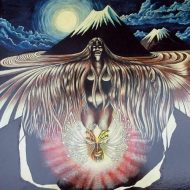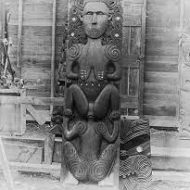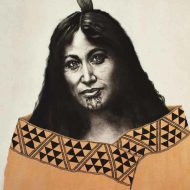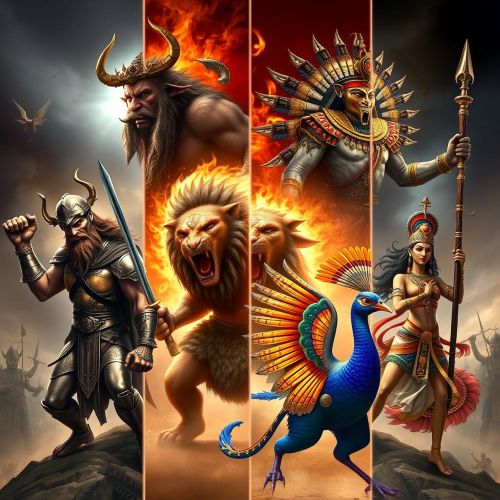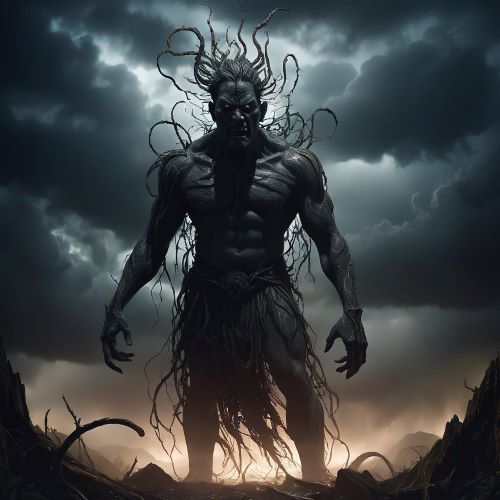Hine Nui Te Po : The Night Goddess
Listen
At a glance
| Description | |
|---|---|
| Origin | Maori Mythology |
| Classification | Gods |
| Family Members | Hine-ahu-one (Mother). Tane Mahuta (Father) |
| Region | New Zealand |
| Associated With | Night, Underworld |
Hine Nui Te Po
Introduction
Hine-nui-te-pō, which translates to “Great Woman of Night,” holds a prominent place in Māori legends1. She is revered as the goddess of the night and the underworld, tasked with the solemn duty of receiving the spirits of humans upon their passing. Within the intricate tapestry of Māori mythology, the presence of Hine Nui Te Po is both prominent and entrancing. Often referred to as the Goddess of Night, her narrative intricately intertwines the themes of creation, mortality, and the unending cycle of life.
Physical Traits
Hine Nui Te Po is frequently depicted as a remarkable and formidable figure, encapsulating the very essence of the night. Descriptions of her include lustrous, obsidian hair that flows like a cascading waterfall of darkness. Her skin, as deep and shadowy as the darkest night, is adorned with celestial motifs of stars and constellations, symbolizing her profound connection to the night sky. Her eyes, possessing a profound, enigmatic quality, are believed to hold the wisdom of ages, reflecting an intricate understanding of the unseen world.
One of her most discerning physical characteristics is her cloak, known as Te Aonui-a-Rangi, which enshrouds her in the mantle of death. This potent garment serves to conceal her true form and signifies her dominion over the realm of the departed. Her presence is often heralded by the nocturnal sounds of the morepork, New Zealand’s indigenous owl, a creature intimately linked with the deity.
Family
Hine Nui Te Po’s connection is deeply rooted in the expansive Māori cosmology and pantheon. In one rendition of the Māori creation narrative, she is presented as the offspring of Tāne Mahuta, the god overseeing the realms of forests and avian life, and Hine-ahu-one, the inaugural woman. Her heritage intertwines her with the genesis of humanity, being born from the very earth (Hine-ahu-one) and entwined with the natural world through Tāne Mahuta.
Within this intricate story, she also assumes the roles of sister and paramour to Tāne Mahuta, signifying a profound and multifaceted connection that underscores the interconnectedness of all aspects within the Māori worldview. This divine genealogical tree serves as the bedrock of Māori mythology, illuminating the functions and responsibilities of the assorted deities that populate their spiritual landscape.
Other names
Her earlier appellation, prior to being known as Hine-nui-te-pō, was Hine-ti-tama. The transformation of her name was prompted by a sequence of events involving her father, Tāne Mahuta. However, in the majority of narratives, she is commonly identified as Hine-nui-te-pō.
Hine Nui Te Po’s nomenclature in Māori mythology is multifaceted, mirroring the profound complexity of her character. Her identity encompasses several aliases, shedding light on different facets of her essence. She is at times recognized as Hine-nui-te-āpo, signifying the “Great Woman of Night.” Another name she assumes is Hinetitama, emblematic of her role as the “First Woman” or the “Dawn Maiden.” These various epithets encapsulate the diversity of her character, from the dominion of the night to the harbinger of light.
Powers and Abilities
Hine Nui Te Po’s remarkable powers and abilities are intrinsically connected to her pivotal role as the Goddess of Night and Death. She stands as the vigilant guardian of the underworld and the dominion of the deceased, ensuring the safe voyage of souls to the afterlife. Her formidable cloak, Te Aonui-a-Rangi, empowers her with the authority to conceal departed spirits and lead them into the enveloping night, where they can find solace.
Among her most profound talents is her mastery over the natural world. She governs the transitions of seasons, tides, and celestial motions. As the Goddess of Night, she conducts the eternal ballet of life and death, a symbolic representation of the cyclical nature of existence. Furthermore, she possesses the remarkable ability to alter her form and name, exemplified in her transformation from Hine-ti-tama to Hine-nui-te-pō.
Modern Day Influence
The enduring influence of the legend of Hine-nui-te-pō reverberates through contemporary Māori culture. Her narrative remains a central element in traditional storytelling, serving as a poignant reminder of the eternal cycle of life and death. The belief that the reddish hue in the sky originates from her legacy continues to be deeply ingrained among Māori communities. Moreover, her story offers a framework for comprehending the intricacies of familial bonds and societal norms within Māori culture.
Hine Nui Te Po’s resonance extends to diverse facets of Māori art, from intricate carvings to traditional tattoos, known as “moko.” These artistic expressions frequently incorporate her iconic cloak and the starry patterns, paying homage to her pivotal role in guiding departed souls to the realm of the ancestors. Furthermore, Māori storytelling, encapsulated in the practice of “whakapapa” or genealogy, consistently weaves references to Hine Nui Te Po into the narrative. This underscores her enduring relevance as a symbol of life’s intricate tapestry and the transition to the spiritual realm.
Modern Māori communities also uphold the legacy of Hine Nui Te Po by invoking her name and attributes in ceremonies and rituals dedicated to the remembrance of the departed. These traditions serve to maintain a profound connection with the deity and ensure that her role as the guardian of the night and the afterlife remains both honored and preserved.
Related Images
Frequently Asked Questions
What is lorem Ipsum?
I am text block. Click edit button to change this text. Lorem ipsum dolor sit amet, consectetur adipiscing elit. Ut elit tellus, luctus nec ullamcorper mattis, pulvinar dapibus leo.
What is lorem Ipsum?
I am text block. Click edit button to change this text. Lorem ipsum dolor sit amet, consectetur adipiscing elit. Ut elit tellus, luctus nec ullamcorper mattis, pulvinar dapibus leo.
What is lorem Ipsum?
I am text block. Click edit button to change this text. Lorem ipsum dolor sit amet, consectetur adipiscing elit. Ut elit tellus, luctus nec ullamcorper mattis, pulvinar dapibus leo.
What is lorem Ipsum?
I am text block. Click edit button to change this text. Lorem ipsum dolor sit amet, consectetur adipiscing elit. Ut elit tellus, luctus nec ullamcorper mattis, pulvinar dapibus leo.
What is lorem Ipsum?
I am text block. Click edit button to change this text. Lorem ipsum dolor sit amet, consectetur adipiscing elit. Ut elit tellus, luctus nec ullamcorper mattis, pulvinar dapibus leo.

